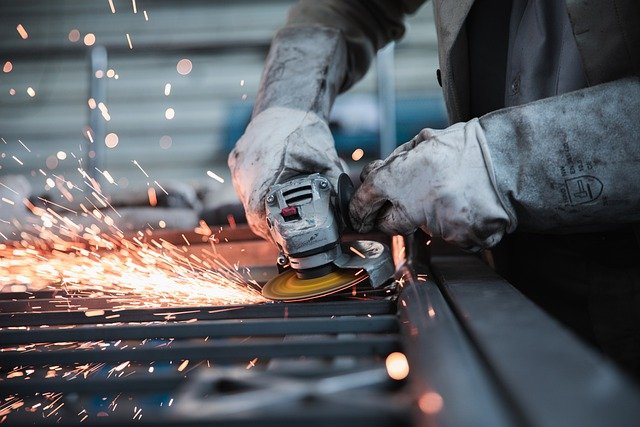The Most Popular Types Of Metals And Their Uses

Did you know that in 2019 the United States produced over 95 million tons of steel? Steel is one of many popular metals used in today’s society, whether for construction, technology, or even jewelry.
Metal is what quite literally keeps our civilization standing, and has been in use since the Bronze Age. Since then, technology and innovation have helped discover new grades and types of metal as well as different applications for them. From the first iron-framed buildings to the construction of the Burj Dubai, metal has been a part of the growth and development of modern-day civilization.
Continue reading to learn about the 3 most popular types of metals in today’s society and their uses.
Types of Metal
Copper
Copper is one of the first metals humans started using, and it’s known for being malleable and highly conductive. This conductivity is both thermal and electrical, and it’s widely used in the electronics industry. The conductivity makes it perfect for circuitry, cables, electrical components, and more.
It’s also very durable, making it a common choice in the construction industry. Various metals are susceptible to rusting, but copper is corrosion resistant so it stands up well to moisture and can last for a long time. The appearance is quite distinctive, so it’s sometimes used decoratively.
Zinc
One of the most well-known characteristics is its corrosion resistance. This makes it ideal for applications that involve exposure to moisture.
It’s often used as a coating for other metals, like iron and steel. Zinc makes it possible to take advantage of the characteristics of these metals (such as durability or cost-efficiency) and prevent them from rusting. It’s also commonly used to produce batteries and other electrical devices.
Brass
Brass is an alloy that’s made by combining copper and zinc, as well as other elements. These sometimes include tin, lead, and aluminum. The result is a versatile material with good corrosion resistance.
It’s ideal for applications where rust could be an issue. It’s easy to shape into different forms, making it ideal for producing musical instruments, locks, hinges, and other intricate items. Like copper, it’s also sometimes used for its attractive appearance
Bronze
Bronze comes from combining copper and tin, and it is the first known alloy to have been made by humans. Though bronze may be brittle, it is great for resisting fatigue and will not bend or crack. It is also corrosion-resistant and a great conductor of both heat and electricity.
Some of the primary uses for bronze are bells, electrical connectors and fasteners, parts on oceangoing vessels, and reflectors. Bronze can mix with other metals to form alloys.
Some other applications for bronze include sculptures and statues. It is also used to make springs and bearings when manufacturing things with moving parts. Bronze is also the primary material for making guitar strings.
Titanium
Titanium is a highly valued metal as it has some distinct properties. Perhaps the most important of these is the exceptional strength-to-weight ratio, and it has a higher strength-to-density ratio than any other metal.
This makes it a popular choice for military equipment such as jet engines and missiles. It also offers excellent corrosion resistance and biocompatibility. Other metals, such as iron and aluminum, are sometimes alloyed with titanium to produce other characteristics.
Titanium is used in a wide range of applications, such as:
- Automotive engines and components
- Aerospace industry
- Military and defense
- Telecommunications devices
- Sports and recreation equipment
- Medical instruments and prosthetics
- Oil and gas equipment for deep-sea drilling
- Chemical processing
- Marine propeller shafts and desalination plant rigging
Aluminum
Aluminum’s popularity stems from it being lightweight, resistant to corrosion, and surprisingly durable. Aluminum was first made in 1825 and is a key component in some of the biggest technological accomplishments in human history.
Because of how lightweight and strong it is, aluminum a main resource used on the spacecraft that helped get humans to the Moon. It also doesn’t rust, making it a very useful material for dealing with the elements. Its only real drawback is that it does oxidize when exposed to salt, so it isn’t a good fit for use on an ocean-going vessel.
Aluminum’s used in a wide range of products. While most people will associate it with its use as soda cans or aluminum foil for cooking, it is widely used to make household appliances as well as aircraft. Aluminum is the ideal metal for making household appliances because of how light and strong it is. It’s also great for refrigeration because of its heat transferring properties that allow a quicker cooling process.
If you’re reading this article on an Apple laptop then it’s likely that the technology you’re using heavily uses aluminum. Apple uses aluminum for the enclosures of their laptops because they are lightweight and durable.
Iron
Iron is one of the most common metals on Earth. It has been widely used for centuries because of its strength and abundance.
One of the main uses for iron is for cooking appliances like skillets because the pores in iron allow it to prevent food from sticking to it. It also has a high melting point so it works great for use as a wood stove.
Due to the density and weight of iron, it is also widely used for manufacturing heavy machinery. Being so heavy and rigid prevents vibrations which makes it perfect for producing heavy equipment.
Steel
Steel stands as the preeminent metal of choice in modern engineering and construction, thanks to its unparalleled blend of strength, durability, and versatility. This marvel of metallurgy is an alloy primarily composed of iron and carbon, with the carbon content serving a critical role. It functions to purge the iron of impurities and residual elements that could otherwise compromise its integrity and performance.
Iron, in its pure state, boasts commendable strength and utility across various applications. However, its high density, coupled with a natural susceptibility to corrosion and rust upon exposure to moisture, significantly limits its efficacy and reliability as a building material. These inherent shortcomings not only present challenges in maintenance but also raise questions regarding its suitability for long-term structural applications. Because of the strength-to-weight ratio of steel, it is coveted for building parts for machinery as well as its use in constructing buildings.
There are over 3,500 grades of steel, so no matter what you are building there is a good fit for you. This is a big reason why steel is the most used metal in the world.
Here are some of the most popular types of steel on the market, and the best applications for each. For an even deeper dive on steel, check out our article on the different types of structural steel.
Stainless Steel
Stainless steel is made by mixing iron, carbon, and chromium. Renowned for its resistance to corrosion and oxidation, stainless steel is a staple in kitchen appliances, medical equipment, and architectural facades. Its aesthetic appeal coupled with low maintenance requirements make it a preferred choice for a wide range of decorative and functional applications.
Alloy Steel
Alloy steel comes from mixing iron with a number of other types of metal. By incorporating elements such as chromium, nickel, and molybdenum, alloy steel offers enhanced properties like improved corrosion resistance and greater strength at high temperatures.
Because it is so customizable, it is popular for use in building projects. You can customize it to suit whatever use you require, and is pretty inexpensive to produce. This makes it suitable for use in pipelines, automotive parts, and power generation equipment.
Carbon Steel
Carbon steel comes from combining iron with carbon. This is the most basic form of steel, categorized based on carbon content into low, medium, and high. Low carbon steel is ideal for construction due to its excellent weldability and malleability. Medium carbon steel finds its use in automotive components owing to its balance of strength and ductility. High carbon steel, with its superior hardness, is favored for cutting tools and wear-resistant applications. It is customizable based on the amount of carbon that is added. Depending on that, it is sorted by category into high, medium, or low carbon steel.
More carbon that is used makes harder steel. On the flip side, using less carbon will provide less expensive steel that is easier to create. The most common use for carbon steel is as a building material because of its strength.
Tool Steel
Tool steel is one of the hardest forms of metal on the planet. Tool steel is made by combining iron with cobalt, tungsten, or vanadium. Because of its hardness, it is great for use in the manufacturing of cutting tools, dies, and molds. Its ability to retain a sharp edge under extreme conditions makes it invaluable in the machining and tooling industries.
The most common use for tool steel is in construction. It is especially useful in the shipbuilding and automotive industries for machining purposes.
Deciding The Right Types of Metal to Use
It can be difficult to know the right types of metals to use for different applications and projects. It’s often best to discuss your needs with professionals to determine the most suitable solution.
Intsel Steel East is a leading steel supplier and we can offer next-day delivery to a range of states in the Northeast. Contact us today for a free quote or to find out more about our quality steel products.






